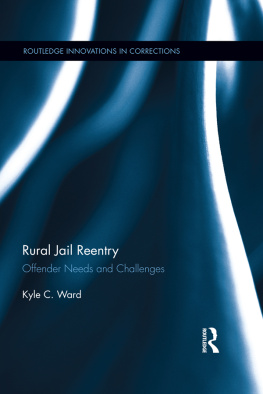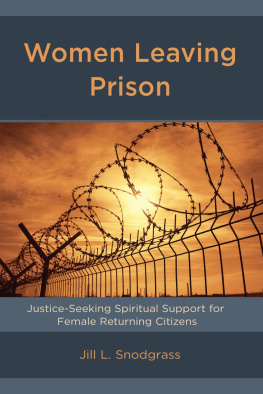Rural Jail Reentry
Todays high recidivism rates, combined with the rising costs of jails and prisons, are increasingly seen as problems that must be addressed on both moral and financial grounds. Research on prison and jail reentry typically focuses on barriers stemming from employment, housing, mental health, and substance abuse issues from the perspective of offenders returning to urban areas. This book explores the largely neglected topic of the specific challenges inmates experience when leaving jail and returning to rural areas.
Rural Jail Reentry provides a thorough background and theoretical framework on reentry issues and rural crime patterns, and identifies perceptions of the most significant challenges to jail reentry in rural areas. Utilizing three robust samplescurrent inmates, probation and parole officers, and treatment staffWard examines what each group considers to be the most impactful factors surrounding rural jail reentry. A springboard for future research and policy discussions, this book will be of interest to international researchers and practitioners interested in the topic of rural reentry, as well as graduate and upper-level undergraduate students concerned with contemporary issues in corrections, community-based corrections, critical issues in criminal justice, and criminal justice policy.
Kyle C. Ward is an Assistant Professor in the Department of Criminology and Criminal Justice at the University of Northern Colorado. His research interests include jail and prison reentry, rural crime, policing, and evidence-based crime prevention strategies.
Routledge Innovations in Corrections
An emphasis on innovation is evident in the field of corrections. While changes in policies and public opinion regarding sentencing philosophies such as mass incarceration bump up against the reality that budgets continue to be tightened and the division of these revenues is more competitive, innovative strategies become all the more valuable. The premise behind innovation is effecting improvements without sacrificing the overall safety and security of the institution. Through research and evaluation, we seek to identify what works and what does not work.
1. The Angola Prison Seminary
Effects of Faith-Based Ministry on Identity Transformation, Desistance, and Rehabilitation
Hallett
2. The Role of Rehabilitation within Californias Correctional System and its Impact on Parole (needs to be put into GT still)
Shah
3. Correctional Rehabilitation and Therapeutic Communities
Reducing Recidivism Through Behavior Change
Pealer
4. Rural Jail Reentry
Offender Needs and Challenges
Ward
First published 2017
by Routledge
711 Third Avenue, New York, NY 10017
and by Routledge
2 Park Square, Milton Park, Abingdon, Oxon, OX14 4RN
Routledge is an imprint of the Taylor & Francis Group, an informa business
2017 Taylor & Francis
The right of Kyle C. Ward to be identified as author of this work has been asserted by him in accordance with sections 77 and 78 of the Copyright, Designs and Patents Act 1988.
All rights reserved. No part of this book may be reprinted or reproduced or utilised in any form or by any electronic, mechanical, or other means, now known or hereafter invented, including photocopying and recording, or in any information storage or retrieval system, without permission in writing from the publishers.
Trademark notice: Product or corporate names may be trademarks or registered trademarks, and are used only for identification and explanation without intent to infringe.
Library of Congress Cataloging-in-Publication Data
A catalog record for this book has been requested
ISBN: 978-1-138-20422-5 (hbk)
ISBN: 978-1-315-46985-0 (ebk)
Typeset in Sabon
by Apex CoVantage, LLC
Research on prison and jail reentry-related barriers typically addresses employment, housing, mental health, and substance abuse issues associated with returning prison inmates. Historically, these challenges are discussed from the perspective of offenders returning to urban areas. The included study explores the challenges inmates experience after leaving jail and returning to rural areas.
The purpose of this monograph is to identify the major challenges offenders face relating to prison and jail reentry and how perceptions of offenders and probation and parole officers are similar or dissimilar. Specifically, this monograph explores the challenges of income, transportation, mental health issues and medication, and interpersonal problems returning offenders must overcome. The study included in this book illustrates that offenders and probation and parole officers may not view their difficulties in reentry similarly.
An objective of the book is to educate and inform readers about rural reentry in particular and some of the unique experiences of rural offenders. It is also intended to enhance students and researchers knowledge of offender reentry in rural areas. This book is split into eight chapters that are outlined as follows.
: Introduction. This chapter briefly identifies the problems associated with mass incarceration, jail, and rural reentry, as well as research of reentry programs and perceptions of reentry needs. The included study is briefly described, identifying the theoretical framework used and the research questions the study will address.
: Issues in Reentry. This chapter expands the introduction to the topic, including a more detailed explanation of the problems relating to mass incarceration and recidivism. This chapter discusses the literature related to prison and jail reentry, including employment, housing, collateral consequences, family and social support, mental health, and substance abuse. Sampson and Laubs (2003) age-graded theory of social control and Cullens (1994) social support framework provide the theoretical background.
specifically examines jail-specific issues with reentry and the programs that have been evaluated addressing jail reentry.
: Rural Framework. The chapter introduces issues related to rural crime, including the problems with the characterization of rural areas, and the possible issues with rural reentry.
describes the previous research relating to perceptions of reentry.
: Methodology. In this chapter, the author provides an overview of how the study was completed. The chapter begins with the definitions of the key terms used and restates the research questions. This study included three separate samples: current inmates, county-level probation and parole officers, and treatment staff. This chapter incorporates information on sample selection and the methodology and procedures used to procure the different samples. The measures in the study are also introduced and described in detail, including the use of principle component analysis in the use of the Perceptions of Reentry Scale and measures of validity and reliability.
: Results. The chapter presents the results of the included study, delineated by each research question. This includes both quantitative and qualitative analysis. For research questions two and three, a total of 72 regression models were run using the subscales determined by the principle component analysis. The chapter ends with a summary of the major findings.
: Discussion. The final chapter provides an overview of the results and outlines how the results of the study relate to previous literature. It also explores theoretical and policy implications, as well as limitations. The chapter concludes with a discussion of the significance of the work and where future research could expand upon it.





